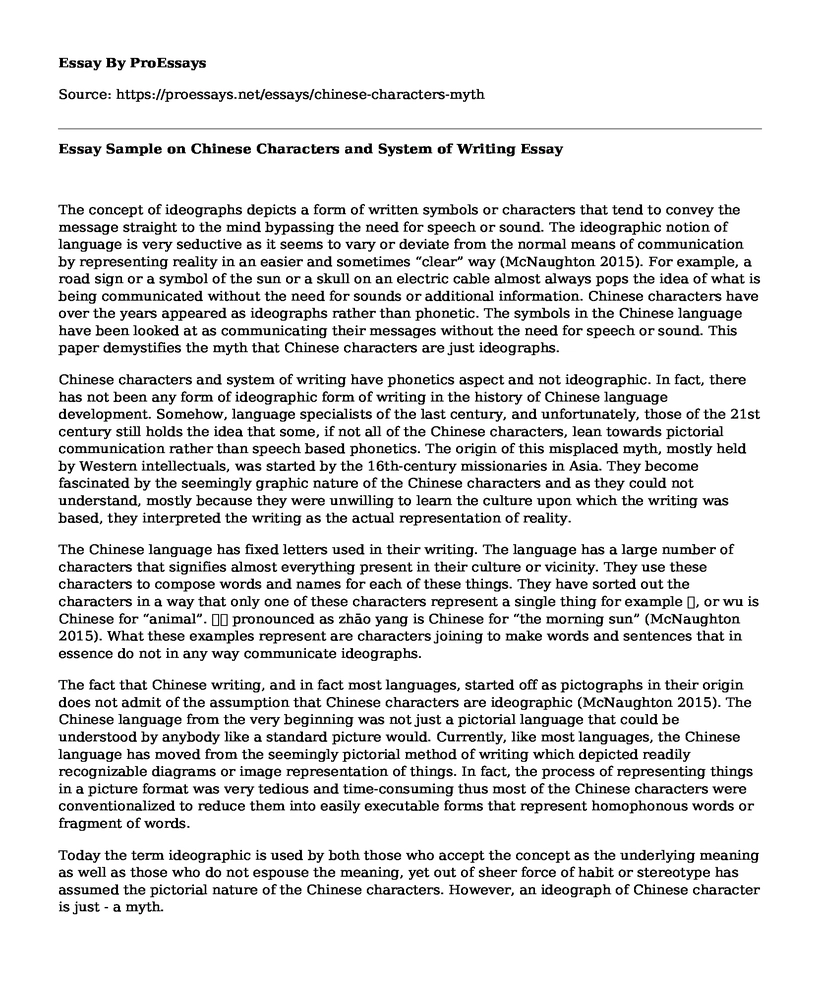The concept of ideographs depicts a form of written symbols or characters that tend to convey the message straight to the mind bypassing the need for speech or sound. The ideographic notion of language is very seductive as it seems to vary or deviate from the normal means of communication by representing reality in an easier and sometimes “clear” way (McNaughton 2015). For example, a road sign or a symbol of the sun or a skull on an electric cable almost always pops the idea of what is being communicated without the need for sounds or additional information. Chinese characters have over the years appeared as ideographs rather than phonetic. The symbols in the Chinese language have been looked at as communicating their messages without the need for speech or sound. This paper demystifies the myth that Chinese characters are just ideographs.
Chinese characters and system of writing have phonetics aspect and not ideographic. In fact, there has not been any form of ideographic form of writing in the history of Chinese language development. Somehow, language specialists of the last century, and unfortunately, those of the 21st century still holds the idea that some, if not all of the Chinese characters, lean towards pictorial communication rather than speech based phonetics. The origin of this misplaced myth, mostly held by Western intellectuals, was started by the 16th-century missionaries in Asia. They become fascinated by the seemingly graphic nature of the Chinese characters and as they could not understand, mostly because they were unwilling to learn the culture upon which the writing was based, they interpreted the writing as the actual representation of reality.
The Chinese language has fixed letters used in their writing. The language has a large number of characters that signifies almost everything present in their culture or vicinity. They use these characters to compose words and names for each of these things. They have sorted out the characters in a way that only one of these characters represent a single thing for example 物, or wu is Chinese for “animal”. 朝阳 pronounced as zhāo yang is Chinese for “the morning sun” (McNaughton 2015). What these examples represent are characters joining to make words and sentences that in essence do not in any way communicate ideographs.
The fact that Chinese writing, and in fact most languages, started off as pictographs in their origin does not admit of the assumption that Chinese characters are ideographic (McNaughton 2015). The Chinese language from the very beginning was not just a pictorial language that could be understood by anybody like a standard picture would. Currently, like most languages, the Chinese language has moved from the seemingly pictorial method of writing which depicted readily recognizable diagrams or image representation of things. In fact, the process of representing things in a picture format was very tedious and time-consuming thus most of the Chinese characters were conventionalized to reduce them into easily executable forms that represent homophonous words or fragment of words.
Today the term ideographic is used by both those who accept the concept as the underlying meaning as well as those who do not espouse the meaning, yet out of sheer force of habit or stereotype has assumed the pictorial nature of the Chinese characters. However, an ideograph of Chinese character is just - a myth.
References
McNaughton, William. Reading & Writing Chinese Simplified Character Edition: A
Comprehensive Guide to the Chinese Writing System. Tuttle Publishing, 2015.
Cite this page
Essay Sample on Chinese Characters and System of Writing. (2021, Mar 22). Retrieved from https://proessays.net/essays/chinese-characters-myth
If you are the original author of this essay and no longer wish to have it published on the ProEssays website, please click below to request its removal:
- Matt's Turning Point in Life Essay Example
- Diversity in English Speaking Countries Essay Example
- Essay Example on Thaddeus Stevens: The Iconic American Citizen
- Essay on Where's Mr. Lion? - Perfect Storybook for Pre-Nursery to Pre-Kindergarten Kids
- Schools: Building Cohesive Environments to Prevent Shootings - Essay Sample
- Hunger in Developing Nations: Effects of Letting a Child Go Hungry - Essay Sample
- Paper Example on Identifying Exceptionalities of Exceptional Students: ESE/94-142/IDEA







